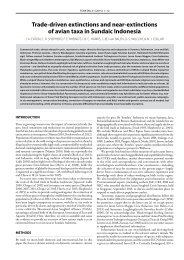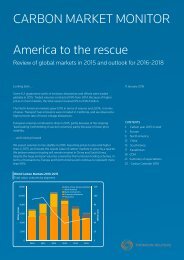Emissions Trading Worldwide
1TbjEHd
1TbjEHd
Create successful ePaper yourself
Turn your PDF publications into a flip-book with our unique Google optimized e-Paper software.
Allowance prices are gradually rising<br />
Allowances are issued by the Californian Air Resources Board and<br />
are sold at quarterly auctions. All bidders pay the same auction<br />
settlement price — the lowest bid above the reserve (floor price).<br />
When compliance began in 2013, the reserve price was 10.71 USD.<br />
As of 2015, this has risen to 12.10 USD and will continue to increase<br />
annually at a rate of 5% plus inflation. In the past three years, the<br />
settlement price has seen a 20% rise from 10.09 USD at the first<br />
auction held in November 2012, to 12.73 USD at the most recent,<br />
sold-out auction in November 2015. To date, the settlement price<br />
has been at or very near the floor price, which has served to keep<br />
the cost of compliance relatively modest.<br />
During the quarterly auction, covered entities also have the<br />
option of buying allowances for future compliance. 4 This regulatory<br />
feature provides further flexibility, as companies can buy future<br />
vintage allowances while the price is low and then bank them for<br />
future use. At the most recent advance auction in November 2015,<br />
all available vintage 2018 allowances were auctioned for 12.65 USD.<br />
“The California-Québec carbon market<br />
provides impetus for the development<br />
and use of cleaner, renewable fuels, and<br />
further evidence that weaning society<br />
from heavy use of fossil fuels need not<br />
be a painful effort.”<br />
Linking with Québec and beyond<br />
California’s Program has been linked with the Canadian Province<br />
of Québec’s Cap-and-Trade system since 1 January 2014; the linked<br />
systems have held joint auctions since fall 2014. This is the first time<br />
sub-national jurisdictions have coordinated and linked their Capand-Trade<br />
systems. Thanks to close consultation and planning,<br />
the linking process has run smoothly. Linkage with Québec has<br />
also increased the environmental and economic benefits of both<br />
systems. Not only are more emissions being reduced, but market<br />
liquidity has also increased. This successful process provides a<br />
model for future linkage, as carbon markets continue to grow and<br />
mature across North America and the rest of the world. Looking<br />
ahead, California and Québec’s joint program may expand even<br />
further with the announcement of a new Cap-and-Trade policy<br />
planned in the Canadian province of Ontario. The three jurisdictions<br />
are currently holding discussions regarding potential linkage.<br />
California is also conducting ongoing conversations with a<br />
number of jurisdictions either already operating or planning a Capand-Trade<br />
program, with the goal to strengthen carbon markets<br />
“To date, the settlement price has been<br />
at or very near the floor price, which has<br />
served to keep the cost of compliance<br />
relatively modest.”<br />
around the world. These jurisdictions include China, Japan, South<br />
Korea, the European Union’s <strong>Emissions</strong> <strong>Trading</strong> System, and the<br />
Regional Greenhouse Gas Reduction Initiative. Discussions are also<br />
underway with other U.S. states, particularly in light of the Obama<br />
Administration’s recently unveiled Clean Power Plan (CPP). Signed<br />
by the U.S. Environmental Protection Agency (EPA) Administrator<br />
in August 2015 and published in October 2015, the CPP regulation<br />
establishes targets for each state to reduce carbon emissions from<br />
existing power plants by 2030. With states given the flexibility to<br />
decide how to meet these targets, the California Cap-and-Trade<br />
Program may provide an attractive compliance model.<br />
California sees its carbon market not only as a means of driving<br />
down emissions, but as a vehicle for building stringent national<br />
and international standards for quantifying carbon reductions.<br />
While the market-based approach has a number of benefits, it is<br />
viewed as a regulatory means to an end, and not an end in itself.<br />
Agreement on solid and verifiable standards for emissions reductions<br />
is critical to mitigating the worst impacts of climate change.<br />
Conclusion<br />
The California-Québec carbon market provides impetus for the<br />
development and use of cleaner, renewable fuels, and further<br />
evidence that weaning society from heavy use of fossil fuels need<br />
not be a painful effort. The growth in awareness of climate change<br />
issues and emissions reduction programs by private businesses,<br />
spurred on by customers and stockholders, is a strong indication<br />
the world is beginning to change direction. The fact is, none of us<br />
are ‘going it alone’ anymore in the battle against climate change,<br />
and a healthy carbon market provides another opportunity for us<br />
to work together to tackle a problem none of us can take on by<br />
ourselves.<br />
international carbon action partnership<br />
13




